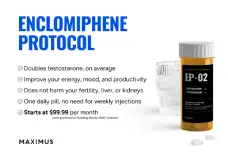@madman Screen shots of labs below -
I inject Tue AM, and Friday pm, 3.5 days apart Started at .3cc per, so .6cc per week, 120mg but felt the estrogen was high so last week lowered to 100 total split same days .25cc each.
I tested Fri AM, 72hrs out. I agree though the cap at 1500, not good enough I know next time I need to get the LC/MS-MS info.
View attachment 51852
View attachment 51853
Thanks.
Okay so as I suspected you had your FT tested using Labcorps direct immunoassay which is known to be inaccurate.
Again you would need to have your FT tested using the most accurate assay the gold standard Equilibrium Dialysis in order to know where it truly sat.
Even then we can easily calcuoate it using the linear law-of-mass action Vermeulen (cFTV) which will give a good approximation and is much more reliable than the known to be inaccurate direct immunoassay.
No one should be using/relying upon such assay for free testosterone.
Seeing as you tested 72 hrs post-injection which would be 12 hrs shy of true trough (84 hrs) than it is clear as day that your close to trough TT was absurdly high 1500+ ng/dL and more importantly close to trough FT would have been very high as in >25 ng/dL and yes even with a high SHBG 67.8 nmol/L.
This also means that your peak TT and more importantly FT will be even higher and throw estradiol in there too!
Again if we take your TT 1500+ ng/dL and seeing as we have no clue where it truy sat as you never had it tested using the most accurate assay (LC/MS-MS) than if we calculate your close to trough using 1500 ng/dL, high SHBG 67.8 nmol/L and Albumin 4.4 g/dL than your close to trough FT is high 25.1 ng/dL.
You are hitting a close to trough FT 25 ng/dL and this is based off a close to trough TT 1500 ng/dL which is most likely even higher which means your FT would be even higher.
Just to put this in perspective.
Recent data from a paper published by highly respected endos/researchers in the game where they used a standardized state-of-the art ED method this would be a breakdown of FT levels.
A FT <5 ng/dL would be considerd low.
FT 5-9 ng/dL would be considered the grey zone where some men may experience symptoms of low-T.
FT 10-15 ng/dL would be healthy.
FT 20-25 ng/dL would be high-end/high.
Even then most healthy young males would be hitting a cFTV 13-15 ng/dL or 10-12 ng/dL tested using the most accuarte assay the gold standard Equilibrium Dialysis and this is a short-lived daily peak to boot!
Daily trough would be 20-25% lower.
The majority of men on testosterone therapy will easily do well with a trough FT 15-25 ng/dL.
Also keep in mind there is a big difference between one hitting a high-end/high trough FT injecting daily vs twice-weekly vs once weekly!
Always need to be mindful of your trough/injection frequency!
If you had truly felt good on your previous protocol minus any sides and overall blood markers are healthy especially RBCs, hemoglobin and hematocrit then I would see no reason to lower your dose.
As you stated:
Not sleeping great and not sure I feel optimal with these high numbers.
Any thoughts on semorelin though (started last night) or lowering my dose of TRT? I'm just not feeling as good as I was on the way up or almost before.....I'm stronger, but puffier, less sleep, and odd digestion which is kinda what happened when I was on enclo and stopped
Yes your close to trough FT would have been high which also means your peak would be even higher.
You easily have room to lower your dose if need be!
Do what you feel is best for you!
*The gold-standard for the determination of FT levels is considered to be directly measured free testosterone (mFT) using equilibrium dialysis followed by mass spectrometry (ED LC-MS/MS). However, no widely accepted reference ranges are available for this clinical parameter. We established mFT reference ranges for healthy men aged 18 to 69 years
Just to be clear up any confusion this is Fiers camps data for mFT reference ranges not the harmonized reference range being worked on by the CDC.
*Serum samples were analyzed from healthy men participating in the SIBLOS/SIBEX and EMAS studies, both population-based cohort studies
* mFT levels were measured in 867 men using ED LC-MS/MS as previously reported (1). Subsequently, 95% reference ranges were determined using the non-parametric method
Reference: 1. Fiers T, Wu F, Moghetti P, Vanderschueren D, Lapauw B, Kaufman JM. Reassessing Free-Testosterone...












